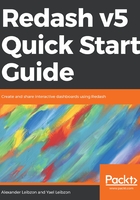
上QQ阅读APP看书,第一时间看更新
Conventions used
There are a number of text conventions used throughout this book.
CodeInText: Indicates code words in text, database table names, folder names, filenames, file extensions, pathnames, dummy URLs, user input, and Twitter handles. Here is an example: "In case you prefer to have more control over the installation, you can choose Docker or manually run the bootstrap.sh script"
A block of code is set as follows:
root@ip-10-69-10-45:/home/bitnami
root@ip-10-69-10-45:/home/bitnami
telnet 54.156.58.190 5432
Trying 54.156.58.190...
Connected to 54.156.58.190.
Escape character is '^]'.
^]
telnet>
Any command-line input or output is written as follows:
ps -ef | grep redash
Bold: Indicates a new term, an important word, or words that you see onscreen. For example, words in menus or dialog boxes appear in the text like this. Here is an example: "To create a new visualization, press the +New Visualization button"
Warnings or important notes appear like this.
Tips and tricks appear like this.